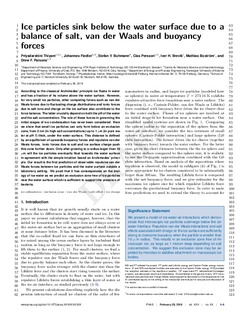| dc.contributor.author | Thiyam, Priyadarshini | |
| dc.contributor.author | Fiedler, Johannes | |
| dc.contributor.author | Buhmann, Stefan Yoshi | |
| dc.contributor.author | Persson, Clas | |
| dc.contributor.author | Brevik, Iver Håkon | |
| dc.contributor.author | Boström, Mathias | |
| dc.contributor.author | Parsons, Drew F. | |
| dc.date.accessioned | 2018-09-05T11:48:35Z | |
| dc.date.available | 2018-09-05T11:48:35Z | |
| dc.date.created | 2018-06-13T02:09:21Z | |
| dc.date.issued | 2018 | |
| dc.identifier.citation | Journal of Physical Chemistry C. 2018, 122 15311-15317. | nb_NO |
| dc.identifier.issn | 1932-7447 | |
| dc.identifier.uri | http://hdl.handle.net/11250/2560968 | |
| dc.description.abstract | According to the classical Archimedes’ principle, ice floats in water and has a fraction of its volume above the water surface. However, for very small ice particles, other competing forces such as van der Waals forces due to fluctuating charge distributions and ionic forces due to salt ions and charge on the ice surface also contribute to the force balance. The latter crucially depends on both the pH of the water and the salt concentration. We show that a bulge in the air–water interface due to interaction of surface tension with the rising ice particle becomes significant when the particle radius is greater than 50–100 μm. The role of these forces in governing the initial stages of ice condensation has never been considered. Here, we show that small ice particles can only form below an exclusion zone, from 2 nm (in high salt concentrations) up to 1 μm (in pure water at pH 7) thick, under the water surface. This distance is defined by an equilibrium of upward buoyancy forces and repulsive van der Waals forces. Ionic forces due to salt and ice surface charge push this zone further down. Only after growing to a radius larger than 10 μm, will the ice particles eventually float toward the water surface in agreement with the simple intuition based on Archimedes’ principle. Our result is the first prediction of observable repulsive van der Waals forces between ice particles and the water surface outside a laboratory setting. We posit that it has consequences on the biology of ice water as we predict an exclusion zone free of ice particles near the water surface which is sufficient to support the presence of bacteria. | nb_NO |
| dc.language.iso | eng | nb_NO |
| dc.publisher | American Chemical Society | nb_NO |
| dc.title | Ice particles sink below the water surface due to a balance of salt, van der Waals and buoyancy forces | nb_NO |
| dc.type | Journal article | nb_NO |
| dc.type | Peer reviewed | nb_NO |
| dc.description.version | acceptedVersion | nb_NO |
| dc.source.pagenumber | 15311-15317 | nb_NO |
| dc.source.volume | 122 | nb_NO |
| dc.source.journal | Journal of Physical Chemistry C | nb_NO |
| dc.identifier.doi | 10.1021/acs.jpcc.8b02351 | |
| dc.identifier.cristin | 1590850 | |
| dc.relation.project | Norges forskningsråd: 221469 | nb_NO |
| dc.relation.project | Norges forskningsråd: 250346 | nb_NO |
| dc.relation.project | Norges forskningsråd: 243642 | nb_NO |
| dc.description.localcode | Locked until 14.6.2019 due to copyright restrictions. This document is the Accepted Manuscript version of a Published Work that appeared in final form in [Journal of Physical Chemistry C], copyright © American Chemical Society after peer review and technical editing by the publisher. To access the final edited and published work see [insert ACS Articles on Request author-directed link to Published Work, see https://pubs.acs.org/doi/10.1021/acs.jpcc.8b02351 | nb_NO |
| cristin.unitcode | 194,64,25,0 | |
| cristin.unitname | Institutt for energi- og prosessteknikk | |
| cristin.ispublished | true | |
| cristin.fulltext | postprint | |
| cristin.qualitycode | 1 | |
